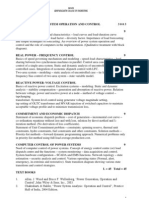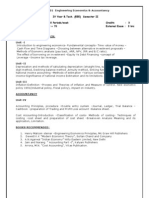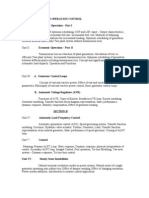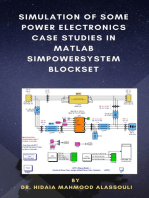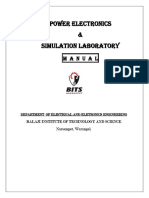Ee2401 Power System Operation and Control
Uploaded by
sshivakumar98Ee2401 Power System Operation and Control
Uploaded by
sshivakumar98EE2401
POWER SYSTEM OPERATION AND CONTROL
LTPC
3003 AIM: To understand the day to day operation of power system and the control actions to be implemented on the system to meet the minute-to-minute variation of system load demand. OBJECTIVES: To have an overview of power system operation and control. To model power-frequency dynamics and to design power-frequency controller. To model reactive power-voltage interaction and the control actions to be implemented for maintaining the voltage profile against varying system load.
UNIT I INTRODUCTION System load variation - load characteristics - load curves and load-duration curve (daily, weekly and annual) - load factor - diversity factor. Importance of load forecasting and simple techniques of forecasting. An overview of power system operation and control and the role of computers in the implementation. (Qualitative treatment with block diagram). UNIT II REAL POWER - FREQUENCY CONTROL 9 Basics of speed governing mechanism and modeling - speed-load characteristics load sharing between two synchronous machines in parallel. Control area concept LFC control of a single-area system. Static and dynamic analysis of uncontrolled and controlled cases. Integration of economic dispatch control with LFC. Two-area system modeling - static analysis of uncontrolled case - tie line with frequency bias control of two-area system - state variable model. UNIT III REACTIVE POWERVOLTAGE CONTROL 9 Basics of reactive power control. Excitation systems modeling. Static and dynamic analysis - stability compensation - generation and absorption of reactive power. Relation between voltage, power and reactive power at a node - method of voltage control - tapchanging transformer. System level control using generator voltage magnitude setting, tap setting of OLTC transformer and MVAR injection of switched capacitors to maintain acceptable voltage profile and to minimize transmission loss. UNIT IV COMMITMENT AND ECONOMIC DISPATCH 9 Statement of economic dispatch problem cost of generation incremental cost curve co-ordination equations without loss and with loss, solution by direct method and iteration method. (No derivation of loss coefficients). Statement of Unit Commitment problem constraints; spinning reserve, thermal unit constraints, hydro constraints, fuel constraints and other constraints. Solution methods Priority-list methods - forward dynamic programming approach. Numerical problems only in priority-list method using full-load average production cost. UNIT V COMPUTER CONTROL OF POWER SYSTEMS 9 Need of computer control of power systems. Concept of energy control centre (or) load dispatch centre and the functions - system monitoring - data acquisition and control. System hardware configuration SCADA and EMS functions. Network topology - state estimation - security analysis and control. Various operating states (Normal, alert, emergency, in-extremis and restorative). State transition diagram showing various state transitions and control strategies. TOTAL : 45 PERIODS TEXT BOOKS 1. Allen. J. Wood and Bruce F. Wollenberg, Power Generation, Operation and Control, John Wiley & Sons, Inc., 2003. 2. Chakrabarti & Halder, Power System Analysis: Operation and Control, Prentice Hall of India, 2004 Edition. REFERENCES 1. D.P. Kothari and I.J. Nagrath, Modern Power System Analysis, Third Edition, Tata McGraw Hill Publishing Company Limited, New Delhi, 2003. (For Chapters 1, 2 & 3)
2. L.L. Grigsby, The Electric Power Engineering, Hand Book, CRC Press & IEEE Press, 2001. 3. Hadi Saadat, Power System Analysis, (For the chapters 1, 2, 3 and 4)11th Reprint 2007. 4. P.Kundur, Power System Stability and Control MC Craw Hill Publisher, USA, 1994. 5. Olle.I.Elgerd, Electric Energy Systems theory An introduction Tata McGraw Hill Publishing Company Ltd. New Delhi, Second Edition 2003
You might also like
- Eee-Viii-Power System Operation and Control (10ee82) - Notes PDF81% (21)Eee-Viii-Power System Operation and Control (10ee82) - Notes PDF130 pages
- EE2401 POWER SYSTEM OPERATION AND CONTROL Syllabus Regulation 2008No ratings yetEE2401 POWER SYSTEM OPERATION AND CONTROL Syllabus Regulation 20082 pages
- 5uee702 Power System Operation and Contr PDFNo ratings yet5uee702 Power System Operation and Contr PDF1 page
- Ee6603 Power System Operation and Control L T P C 3 0 0 3No ratings yetEe6603 Power System Operation and Control L T P C 3 0 0 31 page
- Syllabus: EEE509 Power System Operation and ControlNo ratings yetSyllabus: EEE509 Power System Operation and Control2 pages
- EE3602 POWER SYSTEM OPERATION AND CONTROL SYLLABUSNo ratings yetEE3602 POWER SYSTEM OPERATION AND CONTROL SYLLABUS1 page
- Eee-Viii-power System Operation and Control (06ee82) - Notes100% (3)Eee-Viii-power System Operation and Control (06ee82) - Notes138 pages
- Ee2036 Flexible Ac Transmission Systems L T P CNo ratings yetEe2036 Flexible Ac Transmission Systems L T P C1 page
- EE 2401 Power System Operation and Control PDFNo ratings yetEE 2401 Power System Operation and Control PDF115 pages
- Ee8702 Power System Operation and Control SyllabusNo ratings yetEe8702 Power System Operation and Control Syllabus2 pages
- EE6603-SCAD-MSM - by WWW - LearnEngineering.in PDFNo ratings yetEE6603-SCAD-MSM - by WWW - LearnEngineering.in PDF100 pages
- Power System Operation & Control: - I (10 Hours)No ratings yetPower System Operation & Control: - I (10 Hours)1 page
- Energy Control Center Functions For Power SystemNo ratings yetEnergy Control Center Functions For Power System9 pages
- (PDF) Eee-Viii-Power System Operation and Control (10ee82) - NotesNo ratings yet(PDF) Eee-Viii-Power System Operation and Control (10ee82) - Notes130 pages
- Study of Power System Security in Indian Utility 62 Bus SystemNo ratings yetStudy of Power System Security in Indian Utility 62 Bus System10 pages
- Anna University Tiruchirappalli Tiruchirappalli - 620 024No ratings yetAnna University Tiruchirappalli Tiruchirappalli - 620 02422 pages
- Ee 0403 Power System Operation and Control: Dr. R.Jegatheesan Professor, EEE Department SRM University100% (1)Ee 0403 Power System Operation and Control: Dr. R.Jegatheesan Professor, EEE Department SRM University26 pages
- Simulation of Some Power System, Control System and Power Electronics Case Studies Using Matlab and PowerWorld SimulatorFrom EverandSimulation of Some Power System, Control System and Power Electronics Case Studies Using Matlab and PowerWorld SimulatorNo ratings yet
- Simulation of Some Power Electronics Case Studies in Matlab Simpowersystem BlocksetFrom EverandSimulation of Some Power Electronics Case Studies in Matlab Simpowersystem BlocksetNo ratings yet
- Simulation of Some Power Electronics Case Studies in Matlab Simpowersystem BlocksetFrom EverandSimulation of Some Power Electronics Case Studies in Matlab Simpowersystem Blockset2/5 (1)
- Investigation of the Usefulness of the PowerWorld Simulator Program: Developed by "Glover, Overbye & Sarma" in the Solution of Power System ProblemsFrom EverandInvestigation of the Usefulness of the PowerWorld Simulator Program: Developed by "Glover, Overbye & Sarma" in the Solution of Power System ProblemsNo ratings yet
- Some Power Electronics Case Studies Using Matlab Simpowersystem BlocksetFrom EverandSome Power Electronics Case Studies Using Matlab Simpowersystem BlocksetNo ratings yet
- Methods for Increasing the Quality and Reliability of Power System Using FACTS DevicesFrom EverandMethods for Increasing the Quality and Reliability of Power System Using FACTS DevicesNo ratings yet
- Microsoft Word - DC Machine Notes - SVM - AIT - Unit 01 To 04-VasudevmurthyNo ratings yetMicrosoft Word - DC Machine Notes - SVM - AIT - Unit 01 To 04-Vasudevmurthy19 pages
- Origin of Defects and Positron Annihilation in Hybrid and All-Inorganic PerovskitesNo ratings yetOrigin of Defects and Positron Annihilation in Hybrid and All-Inorganic Perovskites10 pages
- 9619 Hisense Chassis MSD309PX Televisor LCD Manual de ServicioNo ratings yet9619 Hisense Chassis MSD309PX Televisor LCD Manual de Servicio43 pages
- Chapter 01 Fundamentals Lecture 01.04 Thevenin's and Norton's TheoremsNo ratings yetChapter 01 Fundamentals Lecture 01.04 Thevenin's and Norton's Theorems3 pages
- Hy2120 Data Sheet: 2 - Cell Lithium-Ion/Lithium Polymer Battery Packs Protection IcsNo ratings yetHy2120 Data Sheet: 2 - Cell Lithium-Ion/Lithium Polymer Battery Packs Protection Ics22 pages
- Physics Investigatory Project XII Tangent GalvanometerNo ratings yetPhysics Investigatory Project XII Tangent Galvanometer16 pages
- Course Roadmap - Rectification - Bipolar Junction TransistorNo ratings yetCourse Roadmap - Rectification - Bipolar Junction Transistor50 pages
- Lifton Pte LTD Magnets Catalogue 2015 PDFNo ratings yetLifton Pte LTD Magnets Catalogue 2015 PDF84 pages
- Electrical and Electronic Measurements and InstrumentationNo ratings yetElectrical and Electronic Measurements and Instrumentation23 pages
- Datsun Electrical Service Guide Service Manual100% (62)Datsun Electrical Service Guide Service Manual9 pages
- Fuzzy Logic Controller of Photovoltaic Panel-Unified Power Quality Conditioner With Voltage Compensation and StabilityNo ratings yetFuzzy Logic Controller of Photovoltaic Panel-Unified Power Quality Conditioner With Voltage Compensation and Stability12 pages













